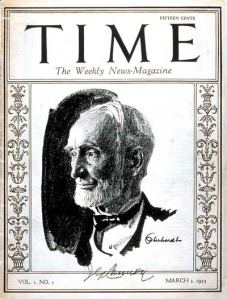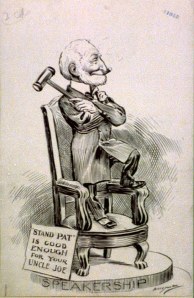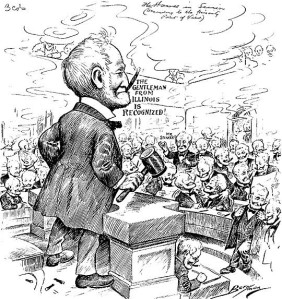Joe Cannon: A Few More Images
November 18, 2010 at 2:23 am | Posted in -- CARTOONS AND CARTOONISTS, Clifford Berryman, Joseph G. Cannon | Leave a commentA few days ago, I mentioned Joseph G. Cannon, Speaker of the US House of Representatives (1903 to 1911), namesake of today’s Cannon House Office Building in Washington, D.C., who served fifty years in Congress (a record back then) and was the only Speaker ever to be stripped of powers in a public revolt on the House floor. For me, part of the appeal of Cannon’s story is that so much of it was captured in images: newspaper cartoons, photographs, campaign posters, and the rest. I thought you might enjoy seeing a few:
First, on the good side, when Cannon finally left Congress in 1923 as 87 year-old elder statesman, Time Magazine put his face on the cover of its first-ever edition.
Here is Joe in his prime as autocratic House Speaker, around 1908. Cannon had a face that cartoonists loved: long, angular, big nose, big ears, white beard, and always the cigar in his teeth. He was tall, lanky, and twitchy, a whirl of motion who swung his awms when he spoke. Cannon was a penny-pinching conservative (“not one cent for scenery”) who believed in “standing pat” — his words — and used his power to block tariff reforms, labor laws, railroad regulation, and the whole Progressive agenda.
How powerful was he? In this front-page Washington Star cartoon by Clifford Berryman, Uncle Joe delights in presiding over a House consising of 390 little clones of himself.
The 1910 revolt to strip Cannon of his powers was a hugh public defeat and embarrassment. Here he is after the fight
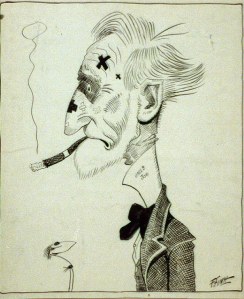
Finally, here is what Joe Cannon actually looked like in 1910. Cannon loved photos like this, with the trademark cigar, the big top havd, and a grin, his eyes betraying no douht about who”s the smarted pertson in the room.
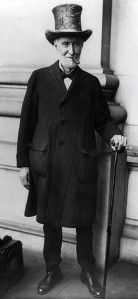
"Uncle Joe" Cannon, Speaker of the House
November 16, 2010 at 5:05 pm | Posted in George W. Norris, John Boehner, Joseph G. Cannon, Nancy Pelosi, Progressive Movement, Theodore Roosevelt, William Howard Taft | Leave a comment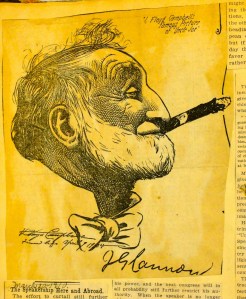 These days, watching Nancy Pelosi and her bloodied, defeated Democrats in the US Congress prepare to surrender power to presumptive Speaker John Boehner and his new Republican majority, I can’t help but think of Joseph G. Cannon.
These days, watching Nancy Pelosi and her bloodied, defeated Democrats in the US Congress prepare to surrender power to presumptive Speaker John Boehner and his new Republican majority, I can’t help but think of Joseph G. Cannon.
Joe Cannon (R-Illinois) — everyone called him “Uncle Joe” — presided as Speaker of the House from 1903 to 1911, the height of Theodore Roosevelt’s era. When he left Congress in March 1923, he had served almost fifty years and been elected twenty-two times, a record back then. Time Magazine that month put his face on the cover of its first-ever edition. Tall, lanky, and outgoing, always a cigar in his teeth, quick with an off-color joke, a back-slapping poker player, Cannon received 58 votes for president of the United States at the 1908 Republican Convention and had his picture on two different brands of chewing tobacco. Above is a newspaper sketch of him from his glory days.
In most history books, Cannon is cast usually as villain, the arch-conservative on Capitol Hill who routinely blocked TR’s progressive ideas, “the vulgar old man who rules the National house” by one Chicago newspaper.
But Joe Cannon, the most autocratic leader ever to assume a chokehold over the National Legislature, also has the distinction of being the only House Speaker ever to be overthrown by his own members in open revolt, to his face, in public session. It was a rare public rebuke, and a signature victory for the then-rising Progressive Movement. Their anti-Cannon revolt, launched in March 1910 and led by young Nebraska congressman and future senator George W. Norris, played out in full public view, an unprecedented spectacle on the floor of Congress, a three-day parliamentary seige during which Cannon had to filibuster from the Speaker’s chair just to be heard. In the end, Norris and his Progressives succeeded in bringing down not just Cannon but also Republican President Willam Howard Taft and a generation of Washington oligarchs. (The snapshot below shows Cannon and Taft, in top hat, shortly before their respective defeats.)
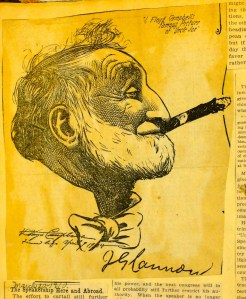 The lesson for Nancy Pelosi and company, however, is not in Cannon’s defeat, but in his comeback. Joe Cannon was 74 years old at the time he was outsted from the Speaker’s chair in 1910. But rather then stewing in bitterness or self-doubt, he jumped right back into action. Cannon’s Illinois neighbors voted him back into Congress in 1914 where Cannon quickly rebuilt his friendships and reputation. He reinvented himself as elder statesman. And when time came for Congress to put names on its three House Office Buildings in Washington, D.C., they picked Cannon’s immediately.
The lesson for Nancy Pelosi and company, however, is not in Cannon’s defeat, but in his comeback. Joe Cannon was 74 years old at the time he was outsted from the Speaker’s chair in 1910. But rather then stewing in bitterness or self-doubt, he jumped right back into action. Cannon’s Illinois neighbors voted him back into Congress in 1914 where Cannon quickly rebuilt his friendships and reputation. He reinvented himself as elder statesman. And when time came for Congress to put names on its three House Office Buildings in Washington, D.C., they picked Cannon’s immediately.
So don’t fret, Democrats. Yes, there are second acts in American life, thanks in part to Uncle Joe. The pendulum will swing back. There will be another day.
Photo of a pleasant afternoon.
June 30, 2009 at 5:20 pm | Posted in Joseph G. Cannon, Teapot Dome Scandal, Warren G. Harding, Woodrow Wilson | Leave a comment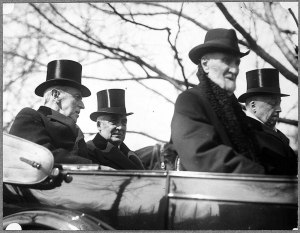 This is one of my favorite snapshots: It’s from Inauguration Day 1921, showing the Presidential limousine en route up Pennsylvania Avenue for the sweaing in. In the back seat, outgoing President Woodrow Wilson, sickly, having suffered a massive stroke (thrombosis) in late 1919, chats quietly with his replacement, incoming President Warren G. Harding, who had trounced Wilson’s party in the 1920 November elections.
This is one of my favorite snapshots: It’s from Inauguration Day 1921, showing the Presidential limousine en route up Pennsylvania Avenue for the sweaing in. In the back seat, outgoing President Woodrow Wilson, sickly, having suffered a massive stroke (thrombosis) in late 1919, chats quietly with his replacement, incoming President Warren G. Harding, who had trounced Wilson’s party in the 1920 November elections.
In the front seat, 84 year-old Joseph G. Cannon (R-Ill), long-time autocractic Speaker of the House nearing the end of his 48 years in Congress, stares ahead. He is without the trademark cigar stub clenched in his teeth, but pointedly refused to wear a formal top hat like the others.
The back-seat conversation?
Warren Harding later described it this way: He said he felt nervous around Wilson Wilson. So, to make small talk, he mentioned during the ride that he had a fondness for elephants based on his sister’s having lived in Siam as a missionary, where she owned one as a pet. When Harding said he always wanted to own one himself, Wilson shot back: “I hope it won’t turn out to be a white elephant.” Wilson laughed.
Where they were going?
The sweaing-in went beautifully that day, the first ever to use an electronic amplifier so people standing in the cold could hear Warrn Harding’s voice. By 1924, Harding’s successor Calvin Coolidge would reach millions through radio. Wilson Wilson, however, grew tired during lunch and went home to rest rather than attend the ceremony.
Woodrow Wilson would die six months after Harding, in February 1924. He would spend his final years convalescing in a townhouse near Washington, D.C.’s Dupont Circle, despondant over his failure to win American approval of the Versailles Treaty, containing a League of Nations. Wilson had negotiated the treaty at the close of World War I and touted the League as justification of the loss of 100,000 American soldiers during the War. The ratification failure left his argument hollow.
As for “Uncle Joe” Cannon, he would serve one more term in Congress and then retire to his home in rural Danville, Illinois. Cannon had been humiliated in 1910 when Congressional “Insurgents” — a coalition of Progressives and Democrats chafing after years of Cannon’s bullying — stripped him of his powers in a famous St. Patrick’s Day uprising on the House floor. As a result, Cannon lost his House seat altogether in 1912. But Cannon, duly chastened, made peace with his enemies and returned to Congress in 1914 for another eight years. Not long after his 1926 death, Congress would honor him by putting his name its massive new office building, today a landmark of Capitol Hill.
Life in the moment.
But for now, they sat there amiably in the limousine, like three normal people on a pleasant afternoon, enjoying the fresh air, the company, and the crowds in the street, ignorant of the dramas ahead. They barely knew each other personally, but were thrown together in a car for a fleeting encounter, each being graceful enough to keep it pleasant. Life is made of moments like this.
Create a free website or blog at WordPress.com.
Entries and comments feeds.
